Attacks on Energy System Are Set to Continue. Are We Getting Ready?
During the two waves of strikes on the power grid in March alone, about 250 drones and missiles were used, causing significant damage. How is it possible that we had been preparing for the attacks since last fall, but turned out not ready for them?
The winter was indeed unexpectedly quiet. Attacks occurred, but the number of drones and missiles was one third of that from the previous winter — “only” about 400. They were quite successfully repulsed and we survived the winter smoothly. The reports of the Ministry of Energy and the Energoatom company became bravura. And then came the last decade of March....
In the first raid, 37 of 60 cruise missiles (not including Kindzhal missiles and S-300 anti-aircraft missiles) were shot down. Not bad, but... more than two dozen broke through to their targets.
As a result, many power plants and substations were damaged to varying degrees. For example, five out of DTEK energy company’s six thermal power plants were under attack, namely the Kryvyi Rih, Prydniprovska, Ladyzhyn, Burshtyn and Dobrotvirska TPPs. Do you know what the sixth one is? The Kurakhove TPP near the frontline, where the number of shelling survivors is already approaching a hundred. There were also heavy attacks on the engine rooms of the plants. Considering that they were hit last winter as well, this affected the condition of the thermal stations even more.
To make restoration efforts more difficult, the Russians attacked the power grid again a week later.
The main focus was on Kharkiv region. There, a series of strikes with S-300 antiaircraft missiles knocked out both of the city’s thermal power plants and severely damaged the border Zmiivska TPP (operated by the Centrenergo company). In essence, they knocked out the main sources of energy production for the entire region.
At the same time, the enemy massively hit Ukrenergo substations and hydroelectric generation facilities. While Dniprovska HPP was attacked in the first wave, Kanivska HPP and Dnistrovska HPP bordering Moldova were hit in the second wave.
In general, more than two million kilowatts of power were taken out of service at the peak, about half of which was hydro generation. As regards nuclear power, the Russians left it intact, expecting that it would cease to function on its own if maneuverable generation collapsed. But it didn’t happen.
Nevertheless, in several regions, mainly frontline ones, millions of energy consumers were without light... The situation is particularly acute in Kharkiv region and, traditionally, in Odesa region.
In most regions, power supply was restored within a day or so. However, many things had to be repaired after the second wave of attacks, some equipment was out of service for a long time, and some of it permanently. In any case, as of today, we realize that the relative restoration of the power system is going to take months.
And these strikes are unlikely to be the last. According to the Main Intelligence Directorate of the Ministry of Defense of Ukraine, Russia has up to a 1,000 missiles with a striking range of over 350 kilometers. Not all of them will be used to destroy our energy sector, of course. Something will remain in stock, but there are enough rockets for several strikes with 60–70 missiles and the same number of drones. The frontline energy facilities are traditionally hit with S-300s and, since some time ago, with glide bombs.
In the winter of 2022/2023, major attacks took place about once every week, which is due to the far-from-perfect condition of Russian strategic aviation. The TU-95 missile-carrying planes are decades old and were designed during Stalin’s reign to fly to Washington. At present, however, they are firing missiles at Dnipro and Zaporizhzhia. The planes have been in use for the third year now and are the worse for wear. We should amplify these risks by new strikes on their bases.
This winter’s strikes have also confirmed the increased maneuverability of enemy cruise missiles and Shahed drones. Their trajectories are becoming more and more sophisticated. For this, special thanks go to the organizers of “gray” schemes in the West since each downed missile contains hundreds of Western components. This, however, is a lyrical digression.
There is also a clear problem with our air defense. There is simply not enough of it for everything, much less to repel group attacks. The supply of anti-aircraft missiles for the past winter, to put it mildly, has not increased, and the mass use of enemy glide bombs at the front does not allow us to strengthen coverage of rear facilities, even strategic ones. Frankly speaking, it is difficult to shoot down supersonic cruise missiles from “tachankas” of air defense maneuvering fire teams.
It is no coincidence that the supply of anti-aircraft missiles was discussed both at the Supreme Commander-in-Chief’s Stavka and publicly, with requests to partners. But the Mexican border is more important to someone. There are opportunities to step up Western supplies; their integration with Soviet-type missiles holds much promise too. But this requires effort. From all of us. And remember that even the most resounding successful cases will not solve the problem completely. In the large energy generation sector alone, about 300 facilities (power plants and substations of both Ukrenergo and oblenergos) need to be protected.
According to a report by the State Agency for Infrastructure Restoration and Development, the first level of protection — against debris — is provided to 103 facilities in 21 oblasts, among them generation and distribution grid facilities. The second level of protection — against drones — is provided to 22 substations in 14 oblasts.
The protection effect became clear during the first strike on nine substations, where the National Agency provided the second level of protection: “Fortification structures at all facilities withstood direct and indirect strikes, providing full protection of autotransformers and electrical equipment...” Of course, at some substations there is damage to the protective structures themselves as a result of direct impacts, but the equipment remained intact, which is the main thing.
Sounds beautiful, but we are talking about gabions and sandbags against shrapnel. They paid two billion hryvnias for it. Our sand is obviously not cheap, probably gold-bearing... Concrete shelters against drones are also being built. They contain less sand, more concrete, and the price is five times higher. But the Agency has a problem with missile shelters. The price of three billion a piece confuses donors. As a result, for the time being, there are presentations of projects and vague promises to settle the issue by the end of the year. If sponsors are found (see figure).
Shelters will continue to be built because the effect of them is quite obvious. In many cases, there is simply no alternative to them.
It is also obvious that attempts to steal money on their construction will continue — there is a world of difference between the cost of construction of similar shelters by Ukrenergo and the abovementioned Agency. Ukrenergo builds faster, better and cheaper. As a result, it has a lot of complaints from people in power, who are prevented by its “bad" example from “utilizing” the money properly.
Given that energy protection is a priority goal, maybe we could somehow extend the practice of “faster, better and cheaper” to the entire sector? It would be nice to hurry up by winter.
Shelters and strengthened air defense will mitigate the problem, but blackout schedules are unlikely to be avoided. Last year, electricity generation was at the level of 105–106 billion kWh. More than half of it was generated by nuclear power plants; thermal power plants (30 billion kWh) and hydro power plants (12.5 billion kWh) accounted for the rest. These are all concentrated, and thus vulnerable, sources of energy. Dispersed renewable energy is only 10.6 billion kWh, i.e., one tenth of total generation. And in winter, when electricity is especially needed, almost no “green” generation capacity is available.
Net consumption in 2022–2023 fluctuated around 86 billion kWh. This is a third less than the pre-war indicator, but even now there is an obvious deficit of about 20 billion kWh after the recent attacks. Import opportunities are limited to less than a billion kilowatt-hours, as evidenced by the results of the last year. It is possible (and, apparently, necessary) to get more, but it will not change the situation drastically. So, alas, the generators, which were not useful this winter, have a chance to come in handy. They are already put to good use in Odesa and Kharkiv.
There is no magic wand that can make a difference. We can only shoot Russian missiles down, hit back, protect infrastructure, build shelters and work.
For starters, we should at least stop making up frankly delusional plans to build megastructures by 2050. Guys, you have the power system in shambles and the beginning of preparation for the heating season 2024/2025 can be considered open. Come on, what sort of groundless projects from the distant future are you even talking about?
It is necessary to actually build new dispersed generation facilities. It is a hackneyed phrase, and officials of the Ministry of Energy mutter it quite automatically and immediately forget that they have voiced it. But this is important, and over the two years of war, very little has been done in this area. And what has been done is mostly the merit of local authorities.
The Ministry of Energy, however, pompously imported an American generator and took selfies with all sorts of visitors against its backdrop, but has not connected it for more than a year. One electric generator. But we need hundreds of generators, small gas-fired, gas-piston and other generators — everything that cannot be hit with a bunch of missiles.
The Russians openly say that one of the goals of the attacks is to drive Kharkiv residents out of the city. The knocking out of both Kharkiv combined heat and power plants is the realization of these plans. At the same time, repair teams have also been targeted. They will not stop. One should not expect miracles — it will not be possible to cover all the needs of the city of one million people when even half of thermal and hydroelectric generation is out of service. It will take a lot of effort, preparation and mini steam plants.
It would also be good to simplify the procedures for issuing permits for new generation as much as possible — not everyone lives according to 2050 plans, and there may be those who are ready to build something now. There is simply no time to discuss projects for months or years. There is not enough time even for paying bribes. We have seven months left, the enemy’s opposition at all levels is guaranteed, and it is better to proceed from the worst-case scenario: the necessity to prevent people and pipes from freezing with no electricity at all.
Read this article in Ukrainian and russian.
Please select it with the mouse and press Ctrl+Enter or Submit a bug













 Login with Google
Login with Google